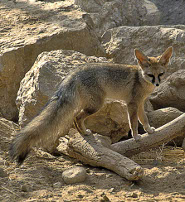

Understanding adaptations and ecological role of the fennec fox is important in identifying its predators.įennec foxes are small, nocturnal animals that inhabit arid deserts in North Africa and parts of the Middle East. The Importance Of Understanding Fennec Fox Predators This article aims to explore some of the common predators of fennec foxes and highlight how these animals have adapted to evade predation over time.

Understanding the predators of fennec fox is crucial for conservation efforts aimed at preserving these fascinating animals’ populations. As with most animals, they have predators that pose a significant risk to their survival.
Blandford fox predators free#
However, fennec foxes are not free from threats in their natural habitat. Despite being considered as one of the smallest species in the family Canidae, fennec foxes possess remarkable adaptations that enable them to survive in harsh environments. These adorable creatures have garnered much attention due to their distinctive physical features, including large ears and a fluffy tail. They are also found in the Middle East, Egypt, and throughout Western Asia.Fennec foxes are small, desert-dwelling canids that inhabit the arid regions of North Africa and parts of the Middle East. They will avoid areas where the red foxes reside. In Arabia, they are found only in the mountains of Saudi Arabia, Oman, Yemen, and United Arab Emirates. It is possible that they are preyed upon as well by leopards, golden eagles, and eagle owls. Death may come via old age or rabies, or they may fall prey to the red fox. Their life span is about four or five years. They make their dens in natural caves and crevices, because they cannot dig their dens. Parents do not take food back into the den.īlandford’s foxes spend a lot of time in dry riverbeds, where they feast on invertebrates, dead animals, birds, and tree fruit. At the age of four months, they begin to forage alone. The pups feed only on milk until they are two months old, at which time they will begin accompanying their parents as they forage. Gestation is 50-60 days, and litters include one to three pups.

Breeding can occur from January to February, but in captivity, it can occur until April. Males and females use neighboring dens while raising young and separate dens for the rest of the year. Its threats include disease, loss of habitat, and the red fox.īlandford’s foxes are monogamous. The IUCN classifies the Blandford’s fox as "Vulnerable" because of small population size and data deficiency. These foxes are considered rare, but because of their extreme habitat, not much is known of them. A black band extends from the neck down the body and tail. Its tail usually has a black tip, though sometimes it has a white one. It has a soft coat of rusty brown, grey, and black. The muzzle is pointed and has a black stripe starting at the eye and reaching to the top lip. The Vulpes cana has a cat-like appearance and demeanor. The Blandford’s fox has a very bushy tail and large ears that overwhelm its slender body. The length of the head and body is about 42 cm, or 16.5 inches, and the tail length is between 28-30 cm, or 11-11.8 inches. The Blandford%u2019s fox ( Vulpes cana), is the second smallest of the fox-like canids.


 0 kommentar(er)
0 kommentar(er)
